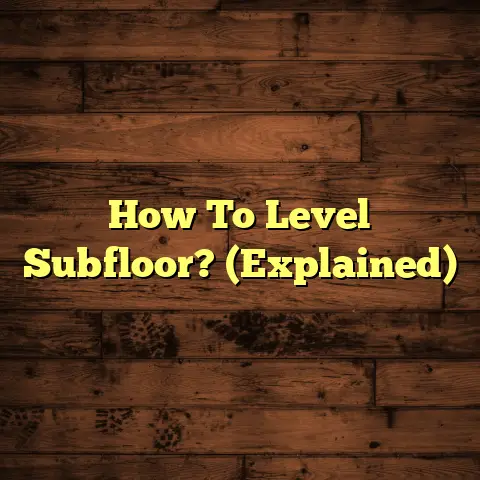How To Finish Tile Floor Going To Stairs With Carpet?
When I first started my journey in the flooring industry, I encountered various challenges, but one problem kept coming up: finishing a tile floor that transitions to a carpeted staircase.
This situation can be a real puzzle for many homeowners and contractors alike.
If not done correctly, it can lead to unsightly gaps, tripping hazards, or an overall unappealing look.
A Story of Transition
I remember a particular project where I was tasked with installing beautiful porcelain tiles in a client’s entryway.
The tiles were glossy and vibrant, perfectly complementing the home’s modern aesthetic.
However, as I approached the staircase leading to the living room—carpeted with a plush, warm fiber—my excitement turned into a concern.
How would I make this transition seamless?
The client was apprehensive about how the two different flooring materials would harmonize.
It was my job to ensure that the transition not only looked good but also functioned well.
This experience pushed me to explore various techniques and solutions, ultimately helping me refine my approach to these transitions.
Breaking Down the Transition Types
Before jumping into methods of finishing tile floors at carpeted stairs, let’s explore the types of transitions you might encounter.
From my experience, understanding these transitions can help set the stage for choosing the best solution.
1. Straight Edge Transition
This is the most common type of transition where the tile meets the carpet at a straight angle.
The key here is ensuring that both materials are level to avoid any tripping hazards.
- Pros:
- Simplistic and clean look.
- Easy to install with transition strips.
- Cons:
- May not work well if there’s a significant height difference.
2. Beveled or Angled Transition
In this case, the edge of the tile is beveled to create a smooth incline into the carpet.
This method can help mitigate height differences and offers a more gradual transition.
- Pros:
- Aesthetic appeal with a custom look.
- Reduces tripping hazards.
- Cons:
- Requires more precision in installation.
3. Curved Transition
For those looking for something unique, a curved transition can be quite striking.
This method involves creating a curve where the tile meets the carpet, providing an organic flow between spaces.
- Pros:
- Adds a unique design element.
- Cons:
- More complex and time-consuming to install.
Tools and Materials for Successful Transitions
To achieve a successful finish between tile and carpet, having the right tools and materials is crucial.
Here’s what I typically gather before starting any project:
- Transition Strips: Available in various materials and sizes.
- Tile Cutter: Essential for precise cuts.
- Measuring Tape: Accurate measurements ensure a proper fit.
- Level: Necessary for checking alignment.
- Utility Knife: Useful for cutting carpet and tack strips.
- Adhesive or Screws: Depending on the type of transition strip used.
Exploring Each Transition Method
Now that we have a solid understanding of different transition types, let’s dive deeper into specific methods I’ve used in my projects, along with their respective challenges and successes.
Method 1: Transition Strips
Using transition strips is often the go-to option for many contractors, including myself.
They create a seamless barrier between tile and carpet and are relatively easy to install.
Installation Steps:
- Purchase the Right Strip: Choose a strip that matches your tile and carpet colors.
Metal strips add durability while wood strips offer warmth. - Measure Accurately: Measure the length where the tile meets the carpet and cut the strip accordingly.
- Secure the Strip: Use adhesive or screws to attach the strip firmly to the subfloor.
Challenges Encountered: I recall a project where I misjudged the length of the transition strip.
It resulted in an awkward gap that needed additional material and time to fix.
Now, I always double-check my measurements before cutting.
Success Story: On another occasion, I used a metal transition strip in a contemporary home that perfectly complemented both the tile and carpet.
The clean lines added sophistication to the entryway while providing necessary protection against wear.
Method 2: Beveling Tile Edges
Beveling edges adds an elegant touch to tile installations.
It requires careful cutting but can yield impressive results when done right.
Process Overview:
- Marking: Indicate where you want to bevel on each tile.
- Cutting: Use a wet saw or angle grinder to create a smooth bevel on the edge of each tile.
- Smoothing Edges: Sand down any rough spots to prevent carpet snagging.
Challenges Faced: During one installation, I found that I had not beveled enough on one side, causing an uneven look when meeting the carpet.
A quick adjustment and re-cutting saved the day, but it taught me about precision in this technique.
Anecdote: Clients often appreciate this method because it gives their home a custom feel.
In one case, I received compliments on how beautifully it integrated with their decor, making me proud of my work.
Method 3: Using Carpet Tacks
Carpet tacks are another effective way to secure carpet at its edge next to tile.
This method provides stability while maintaining aesthetics.
Installation Steps:
- Lay Down Tack Strip: Place it along the edge of your tile.
- Stretch Carpet Over: Pull the carpet taut over the tacks.
- Secure Edges: Press down firmly so that it grips into place.
Challenges Experienced: I’ve learned that if the carpet isn’t stretched enough, it can lead to wrinkles or an uneven appearance.
Ensuring proper tension is key.
Success Example: In one project, using carpet tacks created a seamless look that blended both flooring types beautifully without needing additional transition strips.
It was both practical and visually appealing.
Maintenance Tips for Transitions
Once your flooring project is complete, maintaining those transitions is crucial for longevity and appearance.
Here are some tips I’ve gathered over time:
- Regular Cleaning: Dust and debris can accumulate at transition points, making them look untidy.
Regularly vacuuming helps keep everything neat. - Inspect for Damage: Periodically check for any signs of wear or damage on transition strips or bevels.
Addressing issues early can prevent bigger problems later. - Reapply Adhesive as Needed: If you notice any lifting in your transition strip, reapply adhesive to keep it secure.
- Avoid Excessive Moisture: Moisture can warp both tiles and carpets over time.
Make sure spills are cleaned promptly to maintain integrity.
Incorporating FloorTally into My Workflow
Using FloorTally has streamlined my workflow significantly when handling projects involving transitions between different flooring types.
The software allows me to accurately estimate costs and materials needed for projects quickly.
For example, in estimating costs for a recent project involving tile transitioning into carpet:
- Tile Cost: $3 per square foot
- Carpet Cost: $2 per square foot
- Transition Strip Cost: $1 per linear foot
- Labor Estimate: $1.50 per square foot
By inputting these figures into FloorTally, I generated an accurate budget breakdown in minutes rather than hours of manual calculations.
This efficiency not only saves time but also builds trust with clients as they receive clear estimates upfront.
Analyzing Various Flooring Materials
When considering transitions between tile and carpet, it’s essential to recognize how different flooring materials interact with each other:
- Ceramic Tiles: These tend to be more rigid and may require harder transition strips or beveling for smoother transitions.
- Porcelain Tiles: Similar to ceramic but denser; ensure you use high-quality tools for cutting and shaping edges.
- Natural Stone Tiles: Unique aesthetics but require careful handling during installation due to their weight and fragility.
- Carpet Types:
- Low-pile carpets tend to work best with straight-edge transitions.
- High-pile carpets may necessitate beveled edges or tacks for better integration.
Common Mistakes to Avoid
Through my experiences in flooring installation, I’ve identified several common mistakes that can compromise transitions:
- Ignoring Height Differences: Always measure both flooring types before starting installation; underestimating height differences can lead to unsightly gaps or tripping hazards.
- Rushing Installation: Take your time during installation; rushing can lead to misalignment or poor aesthetics later on.
- Neglecting Client Input: Engaging clients in discussions about their preferences can lead to better results and satisfaction with final products.
- Forgetting About Expansion Gaps: As materials expand and contract with temperature changes, leaving adequate space is crucial to prevent warping or buckling.
Conclusion
Transitioning from tile floors to carpet can be challenging but rewarding when you approach it with careful planning and execution.
Each method has its own advantages and hurdles, but with practice and experience, it becomes easier—and even enjoyable—to create beautiful transitions in any home.
Whether you opt for straightforward transition strips, beveling edges for elegance, or securing carpets with tacks, understanding your options will empower you to make informed choices that enhance both aesthetics and functionality.
Reflecting on my journey as a flooring contractor has shown me just how vital these transitions are in creating cohesive spaces that feel complete.
Each project teaches me something new, allowing me to refine my skills further while delivering exceptional results for my clients.
Incorporating tools like FloorTally has been invaluable in streamlining processes and improving client relations through transparency in budgeting and project planning.
So next time you’re faced with finishing a tile floor going into carpeted stairs, remember these insights—and know that with patience and precision, you can create stunning transitions that elevate any space!





